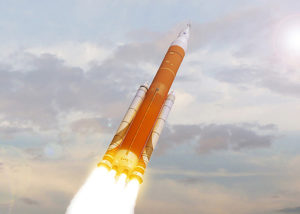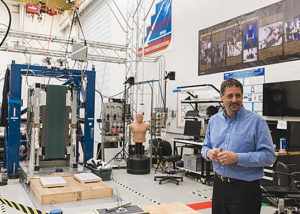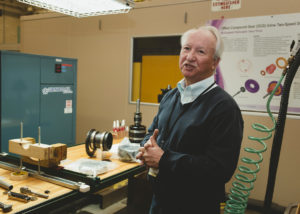Rocketing into the great beyond
NASA, UT degree partnership launched numerous engineering careers
By Laurie B. Davis

It took more than 40 missions and more than 140 spacewalks to assemble, in space, this football-field sized station that serves as home to astronauts conducting daily experiments in biology, human physiology, physical and materials science, and Earth and space science.
To get there, it took the minds and hands of scientists in 15 nations to design, develop, test, build and now support the complex facility. A piece of Joseph Roche (MEng ’90), or more accurately, a few parts he designed for its solar arrays, are attached to the ISS, which has been operating since the first Expedition crew arrived at the station in 2000.
The UT factor
Roche is one of many UT Rockets working for the National Aeronautics and Space Administration’s Glenn Research Center in Cleveland. His colleagues and fellow UT graduates, Robert Corban (MEng ’86) and Dr. Paula Dempsey (PhD Eng’02), also are engineers who manage NASA projects related to the ISS and aeronautics. They are among a total of 80 University of Toledo alumni who work at NASA Glenn.
At the time Roche and Corban were enrolled in master’s programs, UT brought the engineering faculty to the NASA Center in Cleveland. Many scientists earned their advanced degrees from UT at the Glenn facility, including Dr. Rickey Shyne, (MEng ’88, PhD ’98) one of the University’s 2015 Outstanding Alumni award recipients and Director of Research and Engineering at NASA Glenn.
With a bachelor’s degree from Cleveland State University and his master’s degree from UT, Roche recalls working with R. R. Little and Gerald R. Frederick, professor emeritus of engineering, who co-advised him on his thesis work. Roche says Frederick, who studied structural dynamics, was in the civil engineering department in UT’s College of Engineering. “Dr. Little was from the mechanical department, and he put more of a mathematical bent on what I was doing. They were excellent, they were very instrumental in helping me get through the thesis.”
His daughter, Dr. Christine Roche, (MEng ’07), studied bioengineering at UT and was the department’s valedictorian, he says. After getting a PhD in chemical engineering at Berkeley, she’s stayed on to work in bioengineering in California.

Orion’s Mars mission
“To go to Mars is a multi-step process,” says Roche. “We don’t have anything quite big enough in the arsenal, so we’re developing a large rocket so we can position big pieces of cargo, lots of fuel, and then astronauts.” Roche describes the SLS Universal Stage Adapter as a gigantic composite structure with separation systems. Once the rocket launches and propels the capsule onto a trajectory toward its destination, parts attached to the rocket begin to burn off, including the rocket itself, which burns up on its re-entry to Earth’s atmosphere. “It’s an expendable rocket. It’s just to get them out of Earth’s gravitational pull and position them in cis-lunar space,” he says.
“Eventually, we’ll get a crew up there to operate in cis-lunar space,” says Roche. Before any mission to Mars can take place, NASA astronauts, scientists and engineers will need to learn all they can about operating a space-flight mission outside of Earth’s Van Allen belts, says Roche. “How do you keep people alive once you throw them to Mars? You can’t get them back anytime quickly, but around the moon you can get them back fairly quickly. As hardware is developed, NASA will create different missions to help fine-tune the skills that are going to be needed to do a Mars mission,” he says.
A flight, called the Exploration Mission-1, is scheduled for 2018 and will include the Orion capsule on the rocket for launch, but without a crew. This test flight will ensure that all rocket systems are working correctly, says Roche. Exploration Mission-2, a mission set for the year 2021, will include a crew. Before that flight is launched, engineers will upgrade the upper stage of the rocket to handle carrying a crew, says Roche. “That’s when my parts come in; they’re for the upgraded version.”
When astronauts make their Orion mission to Mars, they will collect a lot of data and engage in on-site tests and construction. “They’ll do the geology there; they’re definitely going to be setting up production plants to create fuel, to create power, to sustain life. I imagine there will be a fair amount of horticultural activity to grow food. There’s nothing there, so when you go there, how do you make it work? You can’t bring everything you need, so you have to be able to use in situ what’s there to sustain life, whether it be for power or for radiation protection.”
His first hope for the Mars mission is safety for the people involved. “We’ve got lives at stake here,” says Roche. He also understands the roadblocks and barriers to completing planned missions, having worked on projects that were canceled. “It takes an awful lot of political agreement to keep the mission funded and moving, so I hope we sustain the interest level so we can keep it moving and make some discoveries on Mars.”
Where should we explore and why?
For Roche, space exploration is about more than curiosity. “I think affluent nations can afford to explore. Obviously, poorer nations don’t do it, so you need a relative level of affluence, and when you explore, you might find things that are valuable to go forward. I think we’re trying to extend human presence throughout the solar system,” he adds, “and look for indications of other life forms that might be out there because now, I don’t think there’s any hard evidence that there’s life anywhere.”
Even though Roche once worked in an advanced concepts group for NASA — the people who decide why a mission is important and what to do once arriving at the destination — he says: “I’m the guy to help get you there, not the guy who figures out why you want to be there.”
He says he’s enjoyed working on conceptual ideas and physical design, but overseeing the hardware development for the missions is more to his liking. “I’ve designed pieces of the space station that are still flying after all these years. I did some of the structural testing, the proof testing of the parts that hold the solar arrays — FastMast. So, I’m up there; they’re starting to change the batteries on my hardware now because we had these nickel hydrogen batteries in the old days, and now they’re going to lithium ion.”
Going for a run in space
Robert Corban, chief of the ISS and Human Health Office at Glenn Research Center, directs the work of 18 project managers who are operating ISS research projects, managing the power system on the station, and supporting the combustion and fluid physics science racks, the apparatuses used to conduct experiments on the space station. His team also runs the Telescience System on site — mission control for the ISS at NASA Glenn.

Photo by Caitlyn Witt
“Anything NASA does, we’re trying to advance our knowledge so we can use it for either terrestrial or space application. A lot of our research is directly involved in physical science, how to manage fluids or combustion, how to put out fires,” says Corban. “Exercise devices, and some in [human research program], have been turned into products. With combustion, we’re looking at high-potential spinoffs for automobiles for fuel savings.”
Although Corban earned his master’s degree from UT, he says, “I never set foot on The University of Toledo grounds. I couldn’t attend my graduation because I was traveling for NASA then.” He says he was impressed with the Collegiate Gothic buildings of campus, which he saw for the first time when he brought his daughter, Carli A. Corban, NRS ’10, to campus to attend nursing school.
Beyond space travel
Shyne, who came to campus in 2015 to accept his Outstanding Alumni Award, , joined the Glenn staff in 1984. He currently is one of only 10 directors serving NASA in such a capacity. He says having the UT master’s program on site at Glenn made it more convenient to earn his mechanical engineering degree and for other engineers who took advantage of UT’s advanced degree programs offered at Glenn.
no images were found
In his directorship role, Shyne oversees the analytical, computational and experimental research and engineering efforts to develop technology for aeronautics and human/robotic spaceflight missions. “We are the people developing and testing the new technologies that enable those missions to happen. We address any technical challenges that our aircraft or spacecraft designs may face. What are the technical issues, the roadblocks? Can what we’ve designed handle the stresses of space travel outside of Earth’s atmosphere?” he says.
Shyne’s recent visit to a test site in New Mexico involved evaluating the European Service Module, which will serve as NASA’s Orion crew-transport vehicle. “We have to verify that this system is ready for prime time, which means it can meet mission objectives and safely return astronauts to their families,” says Shyne. “Anytime you develop any new spacecraft for humans to travel in, you need to ensure it functions appropriately and safely.”
For children, especially, and likely for most adults, visions of the moon and stars and astronauts dressed in their 280-pound space suits, which are weightless in space, come to mind when they think of the National Aeronautics and Space Administration. “Whenever people think about NASA, they typically think only of its space programs and missions, when in fact, NASA research has spun off in multiple directions to support many technologies,” Shyne says.
These include but are not limited to: aeronautics and spacecraft that safely get people from Point A to Point B; anti-icing technology that uses computational modeling techniques to manage icing that occurs in certain atmospheric conditions and weather systems; XM Satellite Radio and Dish TV are both derivatives of NASA research and development; and biomedical and biotechnology has introduced distance medicine, in which a patient receiving a mammography screening can be in one location, and the radiologist viewing the X-rays is in another.
In yet another project, says Shyne, NASA Glenn is partnering with a local hospital system, working with cardiologists. The same technology that creates airflow in a gas turbine engine can be applied to blood flow in an artificial heart. Other areas in which technology at NASA benefits society is water quality and purification. Shyne says NASA is flying a specially equipped aircraft over Lake Erie to monitor and collect data on different PH concentrations related to the algal blooms that affect water quality, and a NASA senior scientist recently signed a licensing agreement for his water purification system that uses plasma. Whether NASA is collaborating with business, academia or government agencies, technology transfer has taken off at NASA.
A global perspective of rotorcraft development

Photo by Caitlyn Witt
Dempsey says she’s acquired a new global perspective for supporting Advanced Air Vehicles development in her first year as deputy project manager. “It’s interesting to see how the technology is useful. Now I work as an advocate for other people’s research.”
The researchers develop technologies that benefit the vertical lift community, which in her world can be industry, the U.S. Department of Defense and the Federal Aviation Administration. They are creating new ways to reduce noise and decrease emissions, and increase performance, efficiency and reliability. The research on rotorcraft, such as helicopters, also is expanding to Unmanned Aircraft Systems, otherwise known as drones. The work is supported by three NASA centers—Ames, Langley and Glenn—that each offer specialized expertise. Glenn’s specialty is propulsion systems and includes drives, engines, icing and systems analysis.
“Helicopters are a little bit different than fixed-wing aircraft,” says Dempsey. “The control, the thrust, and lift depend on the rotating rotor on the top. It’s like a rotating wing. Most have two engines and there’s shafting that comes up and rotates the rotor. All of the mechanical systems that are linked together for that rotation have to be engaged and operating properly, otherwise there’s no control, no thrust, no lift,” she says.

Credits: NASA Langley / Oliver Wong
Dempsey’s algorithms that assessed the health of the different mechanical systems, use data analytics techniques, identifying patterns and correlations in the data, similar to data analytics used by search engines, she says. “It’s kind of like the same techniques applied to a different domain.”
From cryogenics to aeronautics
Before Dempsey became engaged in aeronautics at NASA Glenn, she worked as a contractor and then became a civil servant in 1991. She joined an area of space research called cryogenic fluid management systems, developing and evaluating methods to manage cryogenic fluids (liquid hydrogen and nitrogen), to test components, and for testing the long-term cryogenic storage of liquid hydrogen to support a “gas station in space” for a future mission to Mars.
Interested in moving to aeronautics because there were different opportunities available, Dempsey began managing the planning and execution of tests in the Warm Core Turbine Test Facility in 1995. She also earned her master’s degree at Cleveland State University in industrial engineering in 1995 through a NASA-assisted program. NASA would again aid her educational ascent to a PhD by supporting her year of course work and her dissertation research.

Dempsey successfully defended her PhD dissertation and graduated with her UT degree in 2002. “It’s really made a significant impact, because after that I published about 40 papers and presented at conferences. That was a significant advancement in my career,” she says.
As Dempsey and her team of engineers continue to improve helicopter take off and flight, developing technologies to overcome key barriers for vertical lift vehicles, NASA engineers gear up for what they hope is the inevitable mission to Mars. Roche says their progress depends on planned budgets, but he predicts footprints on Mars by 2033. “That’s the sweet-spot year when Mars is closest to Earth, so the mission would be shorter.”
He and his fellow UT alumni are staying the course to improve human life on Earth and on the International Space Station, as they patiently wait for blastoff from Cape Canaveral for Orion’s journey to Mars on the SLS rocket. Says Roche, jokingly, “How could you work at NASA without having a degree from the ‘Rocket,’ and I do rockets!”






